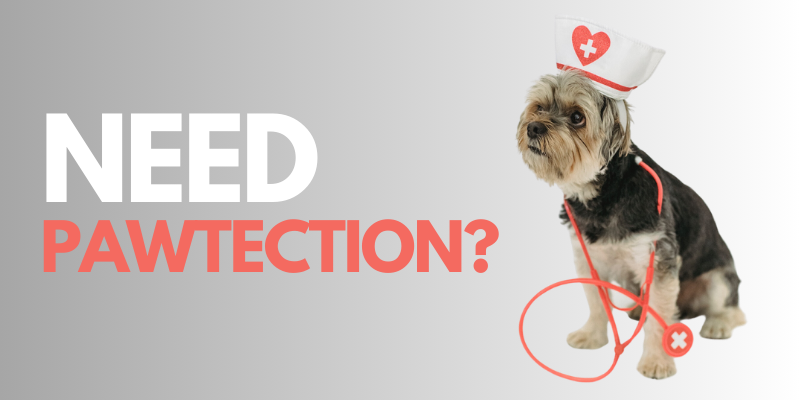Your dog is a valuable family member, and they deserve the best possible care. Giving them the food, love, and attention they need daily is easy, but sometimes their needs go beyond that. What do you do when suddenly faced with the expensive vet bill that inevitably pops up? What about pet insurance? Is insuring your dog worth it and how does dog insurance work?
Whether they eat something they shouldn’t step on a sharp object while running in the park or develop a mysterious illness, at some point, they will need medical attention. You will be asked to pay hundreds or possibly thousands of dollars to provide it.
Much like every other form of insurance, pet insurance is designed to provide financial support during times of financial stress. When your dog needs medical attention, you can say yes to the tests and treatments, knowing that your pet’s insurance will cover some of the cost.
While its purpose mirrors our health insurance, that’s where the similarities end. To make the most of your pet insurance policy, there are a few things you need to understand, starting with how to make a claim.
Making Claims with Pet Insurance

The Claims Process
Pet insurance providers operate on a reimbursement basis, meaning you pay your dog’s medical bills upfront and then file a claim to receive a portion back. The claims process will vary depending on the provider; however, it usually involves the same steps.
Once your dog has visited the vet and you have paid the veterinarian in full, simply fill out a claim form online. If your provider approves it, you’ll receive your reimbursement check in the main or via direct deposit.
Keep in mind that most pet insurance providers have a small claim window. If you fail to file your claim within the allotted time, it will be automatically denied. You will usually have 60 to 270 days to file your claim. The exact time frame should be detailed in your policy or be available on the provider’s website.
Required Documentation
Along with your claim, you will need to submit the required documents. Your provider should offer a list, but you will want to have the following on hand to make the claim filing process go smoothly.
- An itemized invoice provided by the vet.
- Your dog’s medical records from the vet (SOAP) provide an overview of your dog’s medical history.
You will also want to make sure you know:
- The date of the incident and appointment.
- The contact information for the vet.
- The official medical diagnosis and recommended treatment plan.
Reimbursement Procedures
The reimbursement process can be frustrating if you don’t know what to expect and how to navigate it. Here are a few things you need to keep in mind.
- There is a waiting period initially. It is required for all new pet insurance recipients to wait an allotted period before their coverage begins.
- You can only expect reimbursement for care related to medical conditions outlined in your policy. Anything outside of that will not be covered.
- Before your insurance policy can start covering your qualified expenses, the deductible must be paid out of pocket. Depending on your policy, the deductible could be annual or case-by-case. Make sure you read the fine print to know for certain.
- You should not expect a complete reimbursement, even after paying your deductible. All insurance plans include a reimbursement rate. In other words, no matter which provider you choose, only a percentage of your bill will be paid out. Most range from 60-90%; the remaining amount would be paid out of pocket. This out-of-pocket expense is often referred to as a co-pay or cost-share.
- Besides setting a reimbursement rate, most pet insurance policies will charge a payout limit. A payout limit is precisely what it sounds like: a limit to the amount your provider will pay out. Much like a deductible, payout limits can be annual or per case. In other words, you might be limited to $ 5,000 paid out each year or $ 1,000 per claim.
Timelines for Claim Processing
Regarding pet insurance claims, don’t expect your savings to be immediate. It could take a few days to a few weeks for your pet insurance provider to process and approve your claim. Once approved, your check could take a few days to arrive.
Common Misconceptions about Pet Insurance

Pet Insurance vs. Saving Accounts
You can be prepared to provide medical care for your dog in two ways: pet insurance or a savings account. Both are good options. They are even better together. But if you only want to choose one, then it’s essential to weigh the pros and cons.
Starting a pet savings account has no complicated conditions, requirements, deductibles, or claims process. You simply set aside funds and hope you never need to use them. The downside is the upfront cost is higher.
With pet insurance, you may need to deal with monthly fees, deductibles, and long claims processes. Still, the upfront expense is significantly lower, and you can utilize financial resources you might not have otherwise.
Waiting Periods and Coverage Start Dates
Most people don’t realize that most pet insurance providers have a required waiting period before your coverage activates. Any claim filed outside that waiting period will not be approved. The waiting period set by your provider could be anywhere from a few days to a few weeks.
Exclusions and Limitations
The common misconception is that if you have pet insurance, all your dog’s medical expenses will be covered. That simply isn’t true. Even the most comprehensive plans will have limitations and exclusions you must know.
Renewal and Premium Adjustments
To keep your dog’s insurance policy, you will need to renew it each year. However, if you pay your monthly premium using automatic payments, your policy will likely renew automatically. You can also expect that their health risk increases as your dog ages, which means the cost to insure them will also increase.
Tips for Managing Pet Insurance Costs

You might be surprised to learn that pet insurance is affordable, especially when you take the time to tailor your policy to your specific budget and preferences. You can do a few things to get the most value for your money.
- Optimize your coverage level selection. This is the best place to start. Review all your coverage options and pick the one that best meets your needs.
- Adjust your deductibles to manage your premiums. If you are concerned about the monthly premium cost, you can try adjusting your deductible. The higher your deductible, the lower your premium will be, and vice versa.
- Bundle multiple pets under one policy for a discount. Many pet insurance companies will offer a multi-pet discount, allowing you to save money by bundling your pets under the same policy.
- Search for discounts and loyalty reward options. Before you buy, do a little digging. With a little research, you can easily find discounts.
Real-Life Savings
For most of us pet owners, pet insurance feels unnecessary until it isn’t. One of our writers recalls a time when the 9-month-old puppy of one of their friends was rushed to the emergency room three times in one week because they kept eating potentially poisonous items they found while digging in the trash.
Our writer’s friend did not have pet insurance and wound up paying over $2,000 in emergency vet bills.
On the other hand, that same writer’s parents have had pet insurance for years. When their beloved dog Bo needed his teeth removed, instead of paying over $1000, they only paid $300 (a $250 deductible and $100 co-pay).
For a few bucks a month, the equivalent of 5 iced coffees, they were able to save Bo from a potentially fatal infection for a fraction of the cost.
FAQs About Pet Insurance

Will I need to pay all vet bills upfront?
Most likely, yes, you will need to pay upfront and then file a claim to receive partial reimbursement.
What do “Per Condition Limit,” “Annual Limit,” and “Lifetime Limits” mean?
“Per Condition Limit” refers to a limit placed on the amount you can claim for any treatment related to a single condition. For instance, if your dog requires ongoing treatment for an injury, you might only be able to claim a maximum of $ 2,000.
“Annual Limits” refers to a reimbursement limit that applies to all claims filed on your policy within a single year. It resets each time you renew your policy.
“Lifetime Limits” refers to the maximum amount your policy allows you to claim for all treatments and conditions throughout your dog’s life. It does not reset each like the annual, and it is not associated with a single condition. It is connected to your dog’s life.
Could my pet be denied coverage?
Sadly, yes, your dog could be denied coverage. Some providers have a cut-off age; others require vet exams as part of the application process. Some breeds are also considered uninsurable by select providers.
But don’t be discouraged; each provider has its own requirements, so just because one denies you, that does not mean they all will.
Keep in mind that pet insurance providers will deny your coverage if your dog has an ongoing pre-existing condition.
Do vets require pet insurance?
No, pet insurance is not a requirement but rather an optional support.
How much can I expect to pay for pet insurance?
It varies depending on the provider and policy you choose and the age, breed, and general health of your dog. It can be as low as $20 a month for dogs, but good coverage usually averages around $50 a month.
In our experience
At first glance, pet insurance may feel intimidating or confusing, but when you break everything down, it’s not that complicated.
The key is understanding your specific policy inside and out and knowing what to expect. If you are prepared for the limitations and delays, then you can work around them to optimize your coverage so it is the best pet insurance for your doggo!








